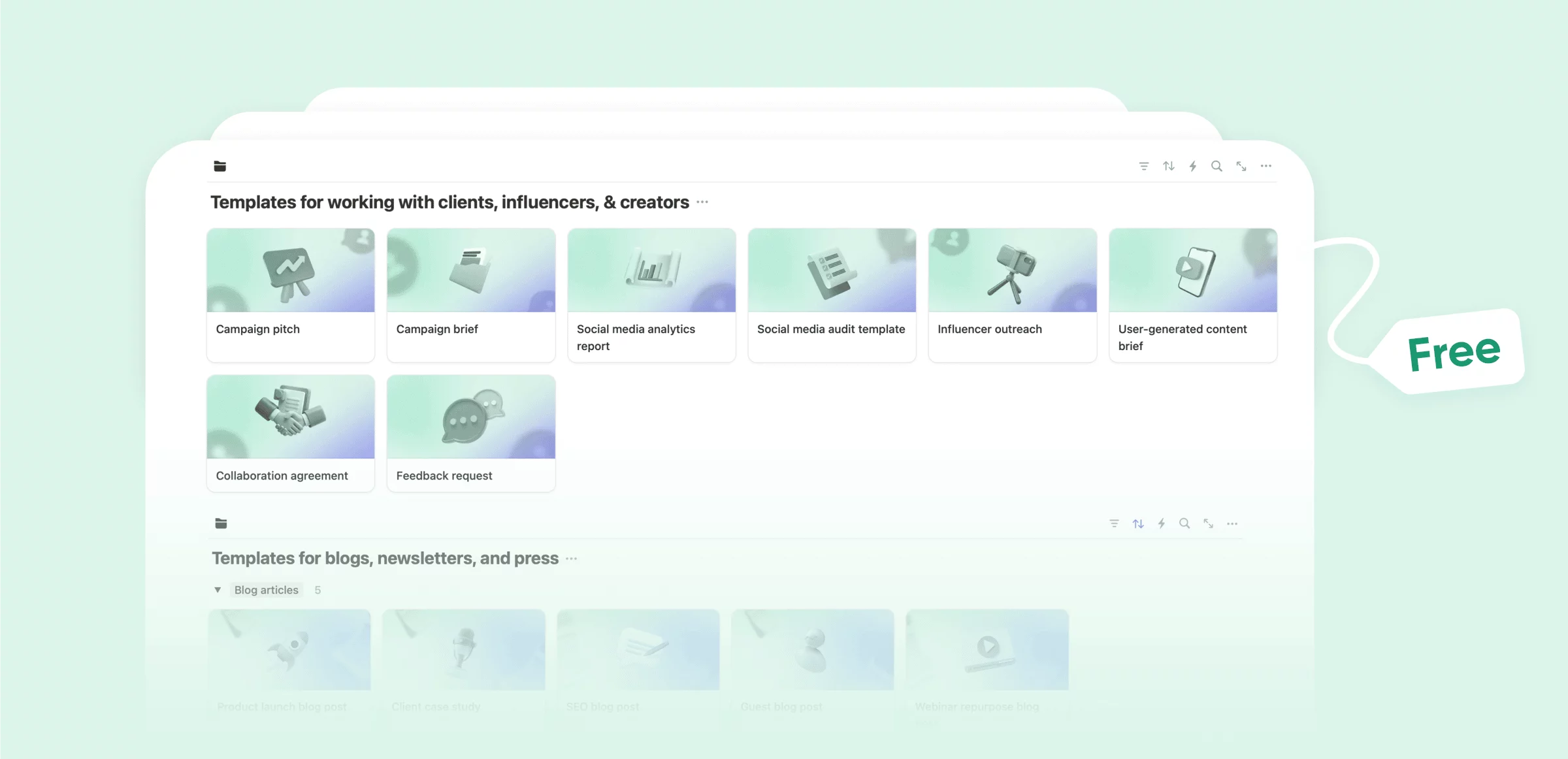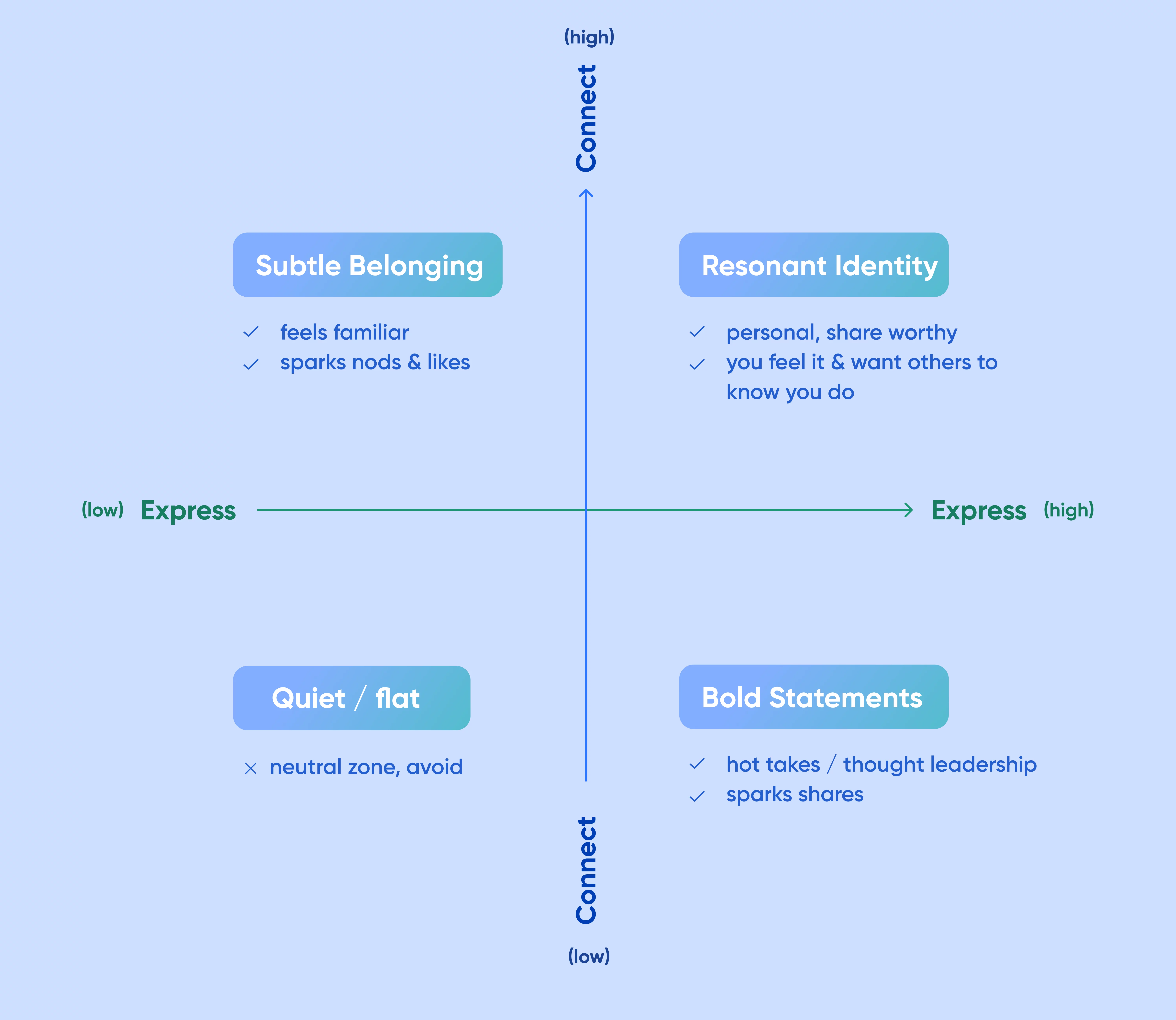We fixate on views, likes, shares, and comment counts. We obsess over the flashy metrics that glitter on our dashboards. But behind every heart and thumbs-up lies something far less superficial: a human feeling.
People don’t engage with your content just because the copy was clever or the graphics were on-brand. They engage because it made them feel something. A spark of recognition. A tug to share. An urge to respond.
3,600 top-performing social media posts across platforms back this up. Two very human instincts, connection and self expression, explain the lion’s share of engagement on social.
Feelings precede clicks. The challenge (and opportunity) for marketers? To double tap those deeper impulses.


Get the free Connect <> Express framework
Metrics are mirrors, not triggers
Your analytics dashboard is a rear‑view mirror. By the time you spot a spike, someone has already felt something. A flicker of connection or the urge to express something out loud. For repeatable reach, start where every swipe begins, in the gut, not the feed.
It’s worth pausing on this domino effect: feeling ⇒ action ⇒ reach.
The emotional spark (connect or express) is quiet. Invisible, even. But the actions it sets off? Super visible. That’s the stuff we track in dashboards and decks: comments, shares, saves, tags. And they all trace back to an intrinsic motivation.
The Connect <> Express framework is a reminder that engagement doesn’t start in the algorithm. It starts with a feeling. And by the time the likes start rolling in, the real magic has already happened, someone felt something. That’s the moment worth chasing.
Instagram, TikTok, LinkedIn and Facebook are all just glorified echo chambers. They listen for echoes of excitement, camaraderie, or identity, and bounce the loudest emotional shouts farther down the tunnel.
A feelings-first content strategy is a strategic edge
Craft a post with a genuine emotional trigger, and you’re effectively enlisting your audience to help market for you.
⇒ A viewer compelled by a Connect cue becomes a mini-distribution channel: “I have to tag my friend, she’ll love this”.
⇒ Someone hit by an Express cue will amplify the content to assert their identity: “I’m reposting this because it says exactly what I’ve been thinking.”
Every one of these feeds the algorithm fresh data about your content’s relevance. And platforms aren’t as mysterious as they seem, they’re just trying to keep up with what people are emotionally responding to. And people follow feelings.
As marketers, we can’t force engagement through hacks or tricks half as well as we can inspire it through emotional resonance.


Get the free Connect <> Express framework
We’re so busy polishing the content, we forget to prime the interaction
We pour energy into the what (the video, the graphic, the copy perfection) but sometimes neglect the human why that would make someone care and respond.
The Connect <> Express framework is a reminder to design each post with the audience’s feelings in mind. Connect and Express are the X and Y axes on a graph. One measures how strongly a post builds community, the other how loudly it lets people signal personal identity.


- Resonant identity. A truly breakout post often scores high on both Express and Connect scales. This is the content that nails both urges and lands in a sweet spot of resonant identity. Posts that feel deeply personal and shareable (you feel it, and you want others to know you do).
- Bold statements. By contrast, a post heavy on Express but low on Connect might come off as a bold statement or even a hot take: it can spark shares for its shock value or opinion, but doesn’t make people feel part of a community.
- Subtle belonging. A post high on Connect but low on Express gives a sense of familiarity*.* It feels relatable, and draws nods and quick likes within a niche group, but it might not ignite widespread sharing.
- Quiet/ flat. And if a post triggers neither urge? It’s background noise: scroll, yawn, next because it neither offends nor excites.
Checklist before publish:
- Which urge am I lighting up: Connect, Express, or both?
- Where’s the frictionless trigger: tag, poll, remix, emoji rail?
- Could the caption stand alone and still land the punch?
If you can’t answer, you’re polishing ornaments, not priming action.


Get the free Connect <> Express framework
The Connect urge: we’re hardwired to bond
Why do we tag our friends in memes or share that “this is so us” post in our group chat?
It’s the Connect impulse in action. A basic human craving for shared experience and belonging. Content that taps into this urge makes people feel part of a community or an inside joke.
Planable’s analysis found that high-performing posts often include Community cues that fuel this sense of togetherness:
- Inclusive language: “we’ve all been there…” or “fellow marketers, you know the feeling…” immediately create camaraderie.
- Tag-a-friend prompts: direct calls to action “Tag your work wife who needs this ☕” invite people to bring others into the conversation.
- Shared identity shout-outs: posts that call out a specific tribe: “Plant parents, sound off 🌱” make the audience feel seen and eager to respond.
- Relatable humor or memes: the classic “Monday mood” GIF or any universally understood joke that says “this is so us” gives people that warm same here! feeling.
- Conversational questions: a quick “Who else still schedules posts at 1 am?” in your caption can spark an OMG, me! moment and prompt replies.
The magic in each is that they encourage human interaction.
And it’s these actions that tell the platform’s algorithm that something real is happening here. A quick tag or “haha yes” comment might seem small, but it’s a sign of belonging, and belonging is addictive.
The “Express” urge: we’re hardwired to declare who we are
If Connect is about “us”, Express is about “me”.
The Express impulse is an equally powerful urge to proclaim our identity, opinions, and emotions.
Great social content acts like a mirror or a megaphone, letting people say, “This is so me.”
In our analysis, Express-driven posts invited followers to react, remix, or flex a little. Tactics that worked:
- Emotional + opinion prompts: “Love it or hate it?” dares people to declare a stance. It’s hard not to weigh in.
- Identity callouts: “Which team are you?” translates to a simple badge of self-identification
- Creativity invites: caption this, duet that, fill in the blank, a.k.a. low-barrier ways to show personality.
- Reaction-friendly content: bold, nostalgic, emotional. Posts that beg for “😮” or “😭” drive people to respond viscerally.
- Visual mic drops: striking imagery or video paired with an identity hook straddles both worlds: aesthetically pleasing, check! Says something about what I stand for or love, double check!
Express content makes people feel seen as individuals. They provide a tiny stage for self-expression, whether that’s an emoji or a full-on rant in the comments.
Higher-effort responses (a fiery comment, a remix, a share to one’s own story with added thoughts) are gold for algorithms. A like is a nod. A share, comment, or remix? That’s a shout. And the louder the shout, the bigger the algorithm boost.
Biggest takeaways per platform
If there was one universal takeaway from our report, it’s this: Reaction is the MVP across all four platforms. Whether it’s funny, inspiring, or just plain unhinged, content that sparks an immediate emotional response is still the fastest route to engagement. Call it the first currency of the internet.
Here’s how that looks across the platforms:
Instagram, your internet moodboard
- Resonance is one of Instagram’s top 3 metrics, which makes sense. Posts that feel like they were pulled straight from your dream life (or therapy session) tend to travel the furthest. We’re talking aspirational-but-attainable visuals, vibes over captions, captions over copy.
- Identity is… present, but not driving the bus. People are curating here, not necessarily claiming a tribe. You’re posting a perfect Sunday, not shouting your values from the rooftops.
Facebook, still tearing up over high school announcements
- Resonance makes the top three here, too. But instead of trendy, it’s tender: nostalgia, community news, and GoFundMe-style causes drive distribution. If your post made someone’s mom cry (in a good way), it’s probably doing well.
- Identity is lower here. People aren’t necessarily aligning with a group, they’re showing up as “everyday me.” It’s less about niche, more about relatable.
TikTok, the secret club you’re lucky to be in
- Tone shows up as a top‑three metric only on TikTok. That conversational, inside‑joke energy is what makes the app feel like a group chat you somehow got added to. The more “frens” and less “followers,” the better.
- Identity is high here so better call people in by naming the club and they’ll practically shout “that’s me!!” back. Subcultures aren’t just welcome, they’re the point.
LinkedIn, the bragging‑rights board
- Status enters the chat as the only platform where it breaks into the top three. Promotions, career wins, and humblebrags dominate. The “new job” post? Still undefeated.
- Identity sits at a mid-level. People lean into their work selves here: polished, professional, LinkedIn-optimized. You’re you’re repping your title, not a subculture.
In the end, it’s not about gaming the algorithm
In 2025’s scroll-happy landscape, algorithm changes are just background noise. The brands that really win? They’re the ones that spark either a “that’s so me” moment or something so spot-on it begs to be shared. Bonus points if you can pull off both. Tug the heart, and yes, the algorithm will reward you.
So for your next brainstorm, slap this on the whiteboard: “What will they feel and what will that feeling make them do?” If you can answer that, the dashboard basically updates itself.


Get the free Connect <> Express framework


Relentless advocate and practitioner of putting users before Google algorithms since 2016. Geeks out over everything tech SEO. Dabbles in photography and is a natural-born reader.